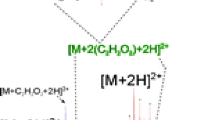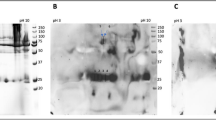Abstract
The purpose of the study is to identify the sites of modification when fibronectin reacts with glycolaldehyde or methylglyoxal as a model system for aging of Bruch’s membrane. A synthetic peptide consisting of the α5β1 integrin binding region of fibronectin was incubated with glycolaldehyde for 12 h or with methylglyoxal for 1 h at 37 °C. After tryptic digestion, the samples were analyzed with liquid chromatography–mass spectrometry (LC/MS). Tandem MS was used to determine the sites of modification. The adducts, aldoamine and N ε-carboxymethyl-lysine, attached preferably at lysine residues when the fibronectin peptide reacted with glycolaldehyde. When the fibronectin peptide reacted with methylglyoxal, modifications occurred at lysine and arginine residues. At lysine residues, N ε-carboxyethyl-lysine adducts were present. At arginine residues, hydroimidazolone and tetrapyrimidine adducts were present. Several advanced glycation endproducts were generated when fibronectin was glycated via glycolaldehyde and methylglyoxal. These results can help explain the structural changes Bruch’s membrane undergoes during aging.





Similar content being viewed by others
References
Adrover M, Vilanova B, Munoz F, Donoso J (2008) Kinetic study of the reaction of glycolaldehyde with two glycation target models. Ann N Y Acad Sci 1126:235–240
Ahmed N, Thornalley PJ, Dawczynski J, Franke S, Strobel J, Stein G, Haik GM (2003) Methylglyoxal-derived hydroimidazolone advanced glycation end-products of human lens proteins. Invest Ophthalmol Vis Sci 44(12):5287–5292
Beattie JR, Pawlak AM, Boulton ME, Zhang J, Monnier VM, McGarvey JJ, Stitt AW (2010) Multiplex analysis of age-related protein and lipid modifications in human Bruch’s membrane. FASEB J 24(12):4816–4824
Brock JW, Cotham WE, Thorpe SR, Baynes JW, Ames JM (2007) Detection and identification of arginine modifications on methylglyoxal-modified ribonuclease by mass spectrometric analysis. J Mass Spectrom 42(1):89–100
Dobler D, Ahmed N, Song L, Eboigbodin KE, Thornalley PJ (2006) Increased dicarbonyl metabolism in endothelial cells in hyperglycemia induces anoikis and impairs angiogenesis by RGD and GFOGER motif modification. Diabetes 55(7):1961–1969
Duran-Jimenez B, Dobler D, Moffatt S, Rabbani N, Streuli CH, Thornalley PJ, Tomlinson DR, Gardiner NJ (2009) Advanced glycation end products in extracellular matrix proteins contribute to the failure of sensory nerve regeneration in diabetes. Diabetes 58(12):2893–2903
Farboud B, Aotaki-Keen A, Miyata T, Hjelmeland LM, Handa JT (1999) Development of a polyclonal antibody with broad epitope specificity for advanced glycation endproducts and localization of these epitopes in Bruch’s membrane of the aging eye. Mol Vis 5:11
Glenn JV, Beattie JR, Barrett L, Frizzell N, Thorpe SR, Boulton ME, McGarvey JJ, Stitt AW (2007) Confocal Raman microscopy can quantify advanced glycation end product (AGE) modifications in Bruch’s membrane leading to accurate, nondestructive prediction of ocular aging. FASEB J 21(13):3542–3552
Glenn JV, Mahaffy H, Wu K, Smith G, Nagai R, Simpson DA, Boulton ME, Stitt AW (2009) Advanced glycation end product (AGE) accumulation on Bruch’s membrane: links to age-related RPE dysfunction. Invest Ophthalmol Vis Sci 50(1):441–451
Glomb MA, Monnier VM (1995) Mechanism of protein modification by glyoxal and glycolaldehyde, reactive intermediates of the Maillard reaction. J Biol Chem 270(17):10017–10026
Handa JT, Verzijl N, Matsunaga H, Aotaki-Keen A, Lutty GA, te Koppele JM, Miyata T, Hjelmeland LM (1999) Increase in the advanced glycation end product pentosidine in Bruch’s membrane with age. Invest Ophthalmol Vis Sci 40(3):775–779
Hasegawa G, Nakano K, Tsutsumi Y, Kondo M (1994) Effects of aldehyde-modified proteins on mesangial cell-matrix interaction. Diabetes Res Clin Pract 23(1):25–32
Hayashi CM, Nagai R, Miyazaki K, Hayase F, Araki T, Ono T, Horiuchi S (2002) Conversion of Amadori products of the Maillard reaction to N(epsilon)-(carboxymethyl)lysine by short-term heating: possible detection of artifacts by immunohistochemistry. Lab Invest 82(6):795–808
Howes KA, Liu Y, Dunaief JL, Milam A, Frederick JM, Marks A, Baehr W (2004) Receptor for advanced glycation end products and age-related macular degeneration. Invest Ophthalmol Vis Sci 45(10):3713–3720
Hussain AA, Starita C, Hodgetts A, Marshall J (2010) Macromolecular diffusion characteristics of ageing human Bruch’s membrane: implications for age-related macular degeneration (AMD). Exp Eye Res 90(6):703–710
Ida H, Ishibashi K, Reiser K, Hjelmeland LM, Handa JT (2004) Ultrastructural aging of the RPE-Bruch’s membrane-choriocapillaris complex in the d-galactose-treated mouse. Invest Ophthalmol Vis Sci 45(7):2348–2354
Lo TW, Westwood ME, McLellan AC, Selwood T, Thornalley PJ (1994) Binding and modification of proteins by methylglyoxal under physiological conditions. A kinetic and mechanistic study with N alpha-acetylarginine, N alpha-acetylcysteine, and N alpha-acetyllysine, and bovine serum albumin. J Biol Chem 269(51):32299–32305
Murdaugh LS, Dillon J, Gaillard ER (2009) Modifications to the basement membrane protein laminin using glycolaldehyde and A2E: a model for aging in Bruch’s membrane. Exp Eye Res 89(2):187–192
Nagai R, Matsumoto K, Ling X, Suzuki H, Araki T, Horiuchi S (2000) Glycolaldehyde, a reactive intermediate for advanced glycation end products, plays an important role in the generation of an active ligand for the macrophage scavenger receptor. Diabetes 49(10):1714–1723
Nagaraj RH, Linetsky M, Stitt AW (2012) The pathogenic role of Maillard reaction in the aging eye. Amino Acids 42(4):1205–1220
Rabbani N, Thornalley PJ (2011) Glyoxalase in diabetes, obesity and related disorders. Semin Cell Dev Biol 22(3):309–317
Rabbani N, Thornalley PJ (2012) Methylglyoxal, glyoxalase 1 and the dicarbonyl proteome. Amino Acids 42(4):1133–1142
Schutt F, Bergmann M, Holz FG, Kopitz J (2003) Proteins modified by malondialdehyde, 4-hydroxynonenal, or advanced glycation end products in lipofuscin of human retinal pigment epithelium. Invest Ophthalmol Vis Sci 44(8):3663–3668
Thorpe SR, Baynes JW (2003) Maillard reaction products in tissue proteins: new products and new perspectives. Amino Acids 25(3–4):275–281
Ulrich P, Cerami A (2001) Protein glycation, diabetes, and aging. Recent Prog Horm Res 56:1–21
Wang Z, Paik DC, Del Priore LV, Burch RL, Gaillard ER (2005) Nitrite-modified extracellular matrix proteins deleteriously affect retinal pigment epithelial cell function and viability: a comparison study with nonenzymatic glycation mechanisms. Curr Eye Res 30(8):691–702
Yamada Y, Ishibashi K, Bhutto IA, Tian J, Lutty GA, Handa JT (2006) The expression of advanced glycation endproduct receptors in rpe cells associated with basal deposits in human maculas. Exp Eye Res 82(5):840–848
Zhang Q, Ames JM, Smith RD, Baynes JW, Metz TO (2009) A perspective on the Maillard reaction and the analysis of protein glycation by mass spectrometry: probing the pathogenesis of chronic disease. J Proteome Res 8(2):754–769
Zhang Z, Yang Z, Zhu B, Hu J, Liew CW, Zhang Y, Leopold JA, Handy DE, Loscalzo J, Stanton RC (2012) Increasing glucose 6-phosphate dehydrogenase activity restores redox balance in vascular endothelial cells exposed to high glucose. PLoS ONE 7(11):e49128
Author information
Authors and Affiliations
Corresponding author
Ethics declarations
Conflict of interests
The authors do not have competing interests and/or commercial relationships.
The work reported here does not invovle human participants or animal subjects.
Rights and permissions
About this article
Cite this article
Thao, M.T., Gaillard, E.R. The glycation of fibronectin by glycolaldehyde and methylglyoxal as a model for aging in Bruch’s membrane. Amino Acids 48, 1631–1639 (2016). https://doi.org/10.1007/s00726-016-2222-3
Received:
Accepted:
Published:
Issue Date:
DOI: https://doi.org/10.1007/s00726-016-2222-3




